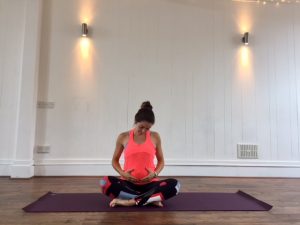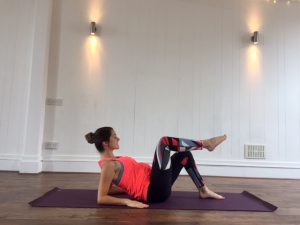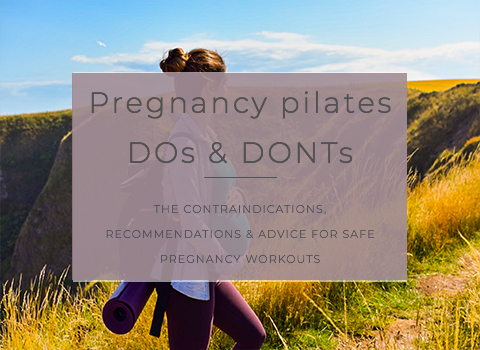There is now so much emphasis on keeping fit during pregnancy, yet the actual guidelines on how to do this safely are somewhat hard to find. Pregnancy pilates can maintain strength, correct changing postures, create mobility, and prepare your body for postnatal adaptations. Here we discuss Pregnancy pilates- how to have a safe workout every time. The contraindications, recommendations and advice explained so that you can be sure your workout is safe for you and baby.
*You should never start a NEW exercise programme during pregnancy without consulting medical advice, and always under expert supervision*
Pregnancy pilates- how to have a safe workout every time
Here we guide you through what to think about when doing pilates in each trimester. All forms of exercise, including pilates should be tailored to your individual health and trimester by a qualified health professional. The best pilates workouts during pregnancy can be found here.
1st Trimester
During the first trimester it is generally safe to continue exercising as you did pre-pregnancy. Your pilates does not require much specific modifications unless you feel unwell, but these tips can help:
- Avoid frequent or rapid changes of direction due to the risk of positional low blood pressure changes & the increased risk of fainting.
- Avoid frequent bending forwards or inversions e.g. having your heart higher than your head.
- Avoid over stretching due to the effects of the hormone Relaxin making joints more lax.
If you are new to pilates it is suggested that you begin with gentle core muscle engagement exercises and pelvic floor exercises. Technique is always important, however even more so when your body changes with pregnancy. Take time here to learn the correct technique when performing core exercises before your body changes. Try these top tips for core exercises to get you started.
Pelvic floor muscle training:
Guidelines suggest these exercises should begin from the very beginning of pregnancy, or at least by week 10 antenatally.
Technique: Begin by drawing in & feeling a lift upwards and forwards closing anal passage through to the vaginal passage. Hold this contraction briefly and then let go and relax fully. Repeat this 10 times. This is your FAST contractions. You would then repeat this process but hold the lift for 10 seconds at a time. This is your SLOW contractions.
Both the FAST and SLOW exercises should be repeated a minimum of 3 times per day. You could also practise contracting your pelvic floor muscles before you lift anything heavy, cough, sneeze, bend over, or perform strenuous exercises. You should also do this during your pilates exercises.
Core activation training:
This is key to mastering prior to performing pilates, and quite frankly any form of strength training. Find your lower abdominal muscles by placing your fingertips on your front hip bones, and then move them approximately an inch inwards and an inch downwards. Gently draw these muscles inwards and hold for 10 seconds. Repeat 10 times.

2nd Trimester
This stage is great for continuing your strength work and keeping your muscles active. Most of the precautions are related to restricting the blood supply to your brain or to the baby. This can occur if you lie flat on your back and compress your major blood vessels.
If you experience any dizziness, light headed feelings, or anything else untoward you should stop immediately and seek advice.
- No supine exercise (lying on your back); use a 30 degree incline only.
- No shoulder bridge exercises.
- Use a pillow between your knees for side lying if required.
- No prone (lying on your tummy); use 4 point kneeling instead.
- Activate your pelvic floor muscles regularly throughout the day as described above.
- Train your core muscles in lying, sitting & standing for full results as this ensures you have trained your muscles in a 3-dimensional state and that they can cope with a range of demands. Try this full body pregnancy workout.
Hormones levels also peak around the middle of the second trimester and this can affect pelvic stability. The hormone Relaxin is released from week 8 onwards therefore ligament laxity has already began by this trimester. Greater emphasis should be placed on exercises to stabilise the pelvis. Be aware of symptoms of pelvic girdle pain, and how to avoid or minimise this (see section further below).

3rd Trimester
This stage is all about maintaining what strength you do have and not pushing it further. This stage is about preparing you for the birth of your baby. IT is to recommended to continue to increase weights, resistance or strain on the body in these final few weeks.
Extra focus should be made to the pilates breathing techniques as these can really assist in keeping you calm, positive, and in control, as well as assisting with labour. Read more on why breathing matters in pilates here.
- Exercise more in the 4 point kneeling position. This can encourage baby to get into their exit route position! If this is uncomfortable on your hands/wrists try using dumbbells under your hands.
- Focus on excellent posture. Try sitting fully upright to ensure adequate space for your bump and less strain on your spine and abdomen. Use a gym ball to sit on for both good posture and gentle core activation. Try this pregnancy workout on the ball.
- Promote circulation exercises. Plenty of repetitions, circular movements and mobilising all major joints will assist with swelling and oedema.
- Make time for relaxation techniques. In this final stage relaxation is essential to ensure a calm mum and a calm baby. Deep breathing, relaxing postures, gentle stretching, and not over doing it are all key factors.

Pelvic girdle pain & pregnancy pilates
This is described as pain “between the posterior iliac crest and the gluteal fold, particularly in the vicinity of the sacroiliac joint, and can occur in conjunction with the symphysis”. Basically anywhere at the back of the pelvis down to your buttock crease, or at the pubic bone.
Practising pilates regularly during pregnancy can certainly help prevent or alleviate pelvic girdle pain. See a specialist physiotherapist for guidance if you are suffering this, and also try these tips below.
- Maintain a neutral pelvic alignment– this means do not have your pelvis tilted forwards or backwards as this places extra strain on the pelvis.
- Use a pillow between your legs in side lying and for sleeping
- Support spine & pelvis with pillows/against walls
- Avoid shoulder bridge exercises
- Take precaution with hip rotational exercises such as clams
- Focus on anterior oblique sling first– this means gain the strength through core engagement first by learning how to do this properly and implementing it prior to every exercise
- Strengthen posterior oblique sling (the back of your body- think back, bottom, legs) to support pelvis with closed chain exercises, sit on ball, ball between knees.
Pregnancy pilates summary
1st trimester: Continue as normal if you feel well. Be aware of dizzy symptoms. Begin pelvic floor & core engagement exercises.
2nd trimester: Take positional and postural adaptations. Continue with safe exercises if you feel well.
3rd trimester: Maintain strength but do not push yourself further at this stage. Modify positions again to keep you are upright with good posture. Focus on breathing techniques.


